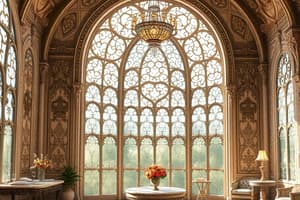Podcast
Questions and Answers
Which of the following is NOT a factor to consider when designing for thermal comfort?
Which of the following is NOT a factor to consider when designing for thermal comfort?
- Thermal inertia
- Humidity (correct)
- Insulation
- Solar gain
Which of the following is NOT a means of transferring thermal energy?
Which of the following is NOT a means of transferring thermal energy?
- Absorption (correct)
- Radiation
- Conduction
- Convection
Why is designing efficient building envelopes important?
Why is designing efficient building envelopes important?
- To cause discomfort
- To reduce the need for insulation
- To reduce the need for mechanical systems (correct)
- To increase energy demand
Flashcards are hidden until you start studying
Study Notes
Understanding Thermal Comfort in Building Design
- Early settlements were designed for mild climates, but as humans moved north, they had to develop different kinds of shelter to be comfortable through changing seasons.
- During the 20th century, we gained unprecedented control over our thermal environment, mainly thanks to energy-consuming equipment such as central heating systems.
- Today, as the world population and expectations of comfort and well-being continue to grow, designing efficient building envelopes is more important than ever to reduce energy demand.
- Thermal comfort is a key factor in ensuring comfort and well-being, and designing efficient building envelopes is one of the first steps to consider.
- The physiological aspect of thermal comfort is largely universal, but thermal comfort varies from one person to another.
- Human bodies are thermal engines that generate and dissipate energy, and we have different ways to balance our constant heat exchange with the environment.
- Thermal energy (heat or cold) can be transferred by three means: conduction, convection, and radiation.
- Local variations within our environment can cause great discomfort, and many other factors influence our perception of our thermal environment, including emotional state, thermal programming, and social background.
- Designing for thermal comfort requires consideration of five main factors: insulation, solar gain, thermal inertia, air tightness, and ventilation.
- A well-designed building envelope can dramatically reduce the need for mechanical systems required to provide thermal comfort, thus reducing environmental impact.
- Climate change will play an increasingly important role in the design of the built environment, and new systems and materials will continue to be developed and refined.
- To be both comfortable and energy-efficient, buildings must be capable of evolving over time, and the key factor in this evolution will be to ask ourselves what levels of thermal comfort will be considered acceptable.
Studying That Suits You
Use AI to generate personalized quizzes and flashcards to suit your learning preferences.




